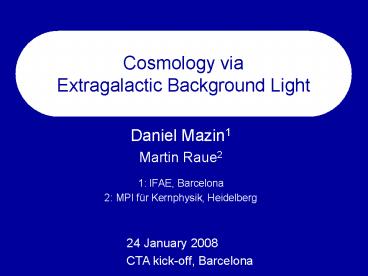Cosmology via Extragalactic Background Light - PowerPoint PPT Presentation
1 / 14
Title:
Cosmology via Extragalactic Background Light
Description:
Resolving contribution of unexpected EBL sources ... galactic. sources. CTA HE. COBE data (Hauser & Dwek, 2001) Goal 3: distance = Hubble parameter ... – PowerPoint PPT presentation
Number of Views:38
Avg rating:3.0/5.0
Title: Cosmology via Extragalactic Background Light
1
Cosmology via Extragalactic Background Light
- Daniel Mazin1
- Martin Raue2
- 1 IFAE, Barcelona
- 2 MPI für Kernphysik, Heidelberg
24 January 2008 CTA kick-off, Barcelona
2
Overview of the talk
- Intro Extragalactic Background Light
- Status of the measurements
- Status of the constraints
- CTA potential
- Resolving contribution of unexpected EBL sources
- Constraining EBL in MIR - FIR
- Measurement of the distances ? Hubble parameter
1
3
AGN emission passes through EBL
?max 1.24 ?m(E/TeV)
- Imprint of the EBL density and shape in the
measured GeV-TeV spectra - GeV-TeV spectra can be used to test EBL density
under certain assumptions about the intrinsic
GeV-TeV spectra
2
4
Extragalactic Background Light (EBL)
- Unique imprint of the history of the universe
- Test of star formation and galaxy evolution
models - Cosmological evolution models have to explain
current EBL - Opacity source for GeV-TeV photons
Redshifted star light
Redshifted dust emission
3
5
Extragalactic Background Light (EBL)
NIR
MIR
FIR
- Direct measurements are difficult
- Lower limits from source counts and stacking
- Upper limits from fluctuation analyses and direct
4
6
VHE ?-rays as probes of the EBL
UV-optical
NIR
MIR
FIR
1 TeV
10 TeV
100 TeV
0.1 TeV
- HEGRA, CAT, Whipple sensitive for 1 ?m to 30 ?m
- HESS, MAGIC and VERITAS 0.4 - 30 ?m
- HESS II and MAGIC II 0.2 - 30 ?m
5
7
EBL constraints from VHE ?-rays
- Upper limits using VHE spectra assumptions
about AGN physics - Recent constraints are already very tight
- HESS II, MAGIC II and GLAST will remove these
uncertainties - Constraints above 10?m rely on a single
measurement of Mkn 501 done by HEGRA in 1997
need more! - References
- Aharonian et al, Nature 440
- MazinRaue, AA 471
- Aharonian et al., AA 475
6
8
Current view
- Either the sources of EBL are resolved by HST,
Spitzer and ISOCAM and there is no big
contribution from exotic sources (e.g. POPIII
stars) - Or AGN assumptions are wrong and current blazar
paradigm has to be revised. - Need more sources at different redshifts
- Need GLAST and low energies
- Need extensive Multiwavelength Campaigns
This issue is addressed to the next generation
HESS II and MAGIC II
7
9
What can CTA do?
10
Goal 1 EBL evolution
- Star and galaxy evolution is largely unknown
- CTA can measure blazar spectra up to redshift z
2 - Such sources are behind the main star formation
epoch ? beacons - Using the sources with zlt2, the EBL evolution can
be resolved! - Need gt100 sources
Star formation rate
Madau, 1998
8
11
Goal 2 EBL at Mid- and Far-Infrared
COBE data (Hauser Dwek, 2001)
- EBL in mid- and far-infrared are crucial for
understanding star and galaxy formation - How much dust?
- What is dust contents?
- How many galaxy populations?
- No direct measurement in the near future
- CTA (high energy array!!) is the only experiment
to test Mid Far-Infrared - Need a few sources
9
12
Goal 3 distance Hubble parameter
Based on Blanch Martinez, 2001
- If one knows
- Intrinsic AGN spectrum and
- EBL density
- determine distance to the sources using the EBL
signature in the measured spectra - Can cover range from z0.004 to z gt 2
10
13
Goal 3 distance Hubble parameter
Based on Blanch Martinez, 2001
- Determination of cosmological parameters
- Independent method
- Required precision 5-10 (in dz/z)
- High potential to determine evolution of Hubble
parameter - need gt100 sources
11
14
Conclusions
- EBL carries essential cosmological information
- VHE spectra put strong limits on the EBL density
- HESS II and MAGIC II will resolve the hard
spectra issue - CTA will
- provide beacons behind the main galaxy formation
epoch (z gt 2) - measure Mid and Far-infrared EBL
- independent distance measurements
- ? cosmology, Hubble parameter































